Freshmen have been excluded from these previews, as we'd like to wait and see what they have to offer on the NCAA level before we come to any long-term conclusions.
-Top 20 Prospects in the Big Ten
-Top 25 Prospects in the ACC
-Top NBA Draft Prospects in the Big 12, Part One (#1-5)
#6 Marcus Denmon, 6'3, Shooting Guard, Senior, Missouri
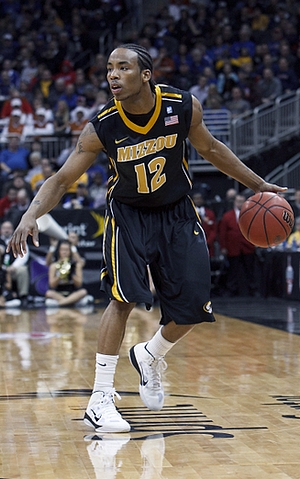
Kyle Nelson
After a solid, but unspectacular two years at Missouri, Marcus Denmon had a breakout junior campaign, emerging as one of the most efficient scorers in college basketball. Denmon led the Tigers to an NCAA Tournament berth while averaging 16.9 points per game on the season.
At 6'3, Denmon is undersized for the shooting guard position and has just an average frame. He is a good athlete, but his lack of size will certainly be an issue at the next level.
Denmon's efficiency stems from his high skill-level and excellent shot selection. Over two thirds of his shots last season came on jumpers according to Synergy Sports Technology, the majority of which came with his feet set. Denmon converted a blistering 47.5% of his those, ranking him amongst the best spot-up shooters in college basketball. He gets excellent elevation on his jumper and has NBA range, showing fluid, consistent shooting mechanics. This is a skill that should translate immediately to the professional level.
More than just a one-dimensional shooter, Denmon also converted a spectacular 54.4% from inside of the arc, ranking as an elite finisher among NCAA shooting guard prospects last year. He is at his best both running the floor and finishing in transition, using his quickness and aggressiveness to get to the basket. He lacks great size even at this level, and is not a terribly explosive leaper, but has excellent body control, the ability to finish with either hand, and excellent toughness around the basket.
Denmon tends to struggle elsewhere, however, lacking the elite ball-handling skills needed to create his own shot in the half-court consistently. Not a threat on the pick and roll, he doesn't change speeds very well and struggles to change directions with the ball if his initial drive is cut off. Furthermore, his jump-shot loses significant accuracy if forced to pull-up off the dribble, as he converted just 11 of his 50 attempts of this nature last year. These are all skills that professional guards are expected to possess in their arsenal, of which Denmon doesn't show much of at the moment.
It is certainly of note, too, that Denmon was the least turnover prone guard in DraftExpress's database in 2010-2011. While his shot-creating abilities must improve, he does a great job staying within himself, which is the reason he was so efficient for Missouri last year. While he is certainly more of an undersized shooting guard than a real combo, his basketball IQ is quite good.
On defense, Denmon demonstrates very good lateral quickness, which combined with his toughness and aggressiveness, allows him to guard all backcourt positions at the collegiate level. This likely won't be the case in the NBA, but his effort level certainly helps his cause. He averages a solid 2.4 steals per 40-minutes pace adjusted, which speaks to his abilities as a man-to-man defender and his general defensive savvy.
Ultimately, Denmon still has his work cut out for himself in improving his NBA prospects despite being the leader of a veteran Missouri team with apparently excellent intangibles. While there is no doubt that some NBA teams could use his combination of perimeter shooting and defense, he is undersized for an NBA shooting guard and lacks a diverse offensive repertoire to compensate.
On a team that is loaded with ball-handlers, Denmon may not have many opportunities to work on the aspects of his game that NBA scouts will want to evaluate this season. Nevertheless, with a deep run into March, and a good showing at Portsmouth, Denmon should be able to endear himself enough with all the positives he brings to the table to at least give himself a fighting chance at being drafted.
#7 Anthony Jones, 6-10, SF/PF, Senior, Baylor
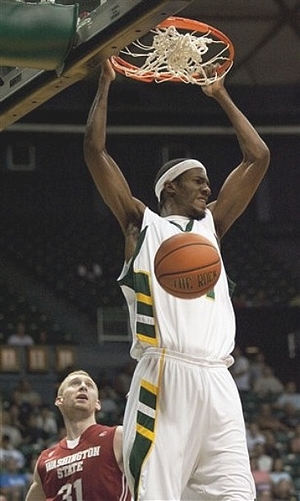
Joseph Treutlein
Steadily improving his game throughout his first three years in college, Anthony Jones has developed into a serviceable role player for Baylor, and with his ample size and length for his position, is bound to start getting more attention from NBA scouts as a senior. While Jones brings some intriguing abilities to the table from an NBA perspective, he's still very raw and is a very unorthodox prospect.
Standing 6'10 with great length and just decent athleticism, Jones weighs in at an unbelievable 190 pounds, which is almost unheard of for a player his height and age. Jones by no means has a great frame, particularly in the lower body, but can certainly put on more bulk, which actually would likely help more than hurt his athletic abilities. Jones doesn't stand out in either his quickness or explosiveness, being mobile but not especially fluid, and showing nothing in terms of ability to finish with power around the basket.
Where Jones does most of his damage at this stage is with his jump shot, as 40% of his field goal attempts come from behind the arc, where he's hitting a very solid 39.4% (and an equally impressive 81.8% at the free-throw line). Jones plays much more like a small forward than a power forward, with almost all of his possessions coming on spot-up jumpers and pull-up jumpers in space.
Looking at Jones' shot, he doesn't have textbook mechanics, shooting from a bit of a staggered stance and having a noticeable hitch in his shot, but he's very consistent with his motions and has both a high and quick release, especially for a small forward. Jones does a good job getting open and being ready to quickly catch and shoot, being reliable spotting up and occasionally coming around screens in space. On pull-ups, Jones doesn't show much ability to separate from his defender and does much of his damage in open space, but his excellent length allows him to shoot over the opposition when he is closely contested.
Jones also shows a bit in terms of attacking the basket, having a somewhat controlled dribble on straight-line drives to the rim, where he surprisingly goes right more than left despite being left-handed. He has a capable floater in his arsenal and can finish decently around the basket with either hand, but clearly shows trouble when matched with weak-side help, as he doesn't show the ability to finish through contact or power up around the basket, evidenced by how little he gets to the free-throw line at 2.9 attempts per-40.
Jones is also extremely limited in terms of his ability to create his own shot, as of the 233 possessions Synergy logged for him this past season, just 19 were of the post-up or isolation variety, with everything else coming operating off the ball.
Jones also does a solid job pursuing offensive rebounds for a small forward, using his size and length well, where his touch allows him to finish at a high rate despite his lack of reactiveness and power. While his rebounding comes off as a positive for a small forward, he's well below average rebounding on both ends if you're evaluating him as a power forward, averaging just 7.1 rebounds per 40 minutes this past season.
On the defensive end, Jones shows a good motor and ability to use his length to contest perimeter shots, but he shows severe problems moving laterally to defend isolations, suffering from a very high center of gravity and less than fluid movements. He's frequently beat by his man and could project as a liability defending 3's in man to man isolation situations in the pros. It's also worth noting despite his excellent size and length, Jones averaged a very underwhelming 0.6 steals and 0.4 blocks per game in 29.8 minutes, being mostly a non-factor off the ball as well.
Looking forward, Jones' excellent size and length combined with his sweet shooting touch from three will make him an intriguing workout candidate for NBA teams to evaluate in the pre-draft process, but his rawness and liabilities in other areas will be difficult to overcome without significant physical improvements. Maximizing his strength and athleticism will be critical for his success, as doing so will allow him to improve defensively, on the glass, and with his ability to finish in the paint. It will be interesting to see how he develops in his senior year.
#8 Quincy Acy, 6-7, Power Forward, Senior, Baylor
Having profiled Acy fairly late in the season with a comprehensive scouting report, we've elected to wait and see what type of progress he's made with a fresh perspective in a few months, rather than rehashing many of the same comments made last year based off his 2010-2011 game footage.
#9, Laurence Bowers, 6-8, Power Forward, Senior, Missouri
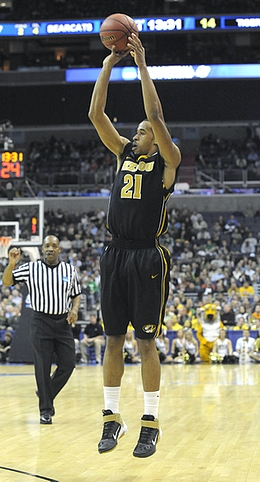
Walker Beeken
Missouri's Laurence Bowers (along with teammate Kim English) tested the waters of the NBA draft after last season and ultimately decided to withdraw his name and return to school. Now, in his senior season, and playing for a new coach in Frank Haith, Bowers will have his final opportunity to showcase his game for NBA scouts, which should give them a better idea of how his game is developing and how it might translate to the NBA level.
We last wrote about Bowers mid-way through his sophomore season as he was emerging as an intriguing prospect to keep an eye on, thanks to increased playing time and his excellent physical tools. Unfortunately for Bowers, his on-court production stagnated as a junior, mainly due to the lack of development in his skill level.
While Bowers has been playing almost strictly as a big man at Missouri, we noted before that he has the mobility and athleticism to eventually see some minutes on the perimeter as well. So far though, he hasn't shown the improvement as a shooter or ball-handler that would seem to make that transition possible.
Bowers progress as a shooter is something to watch closely this season, as he seemed to regress as a junior. He connected on only 31% of his jumpers last season (he made a solid 40% as a sophomore) and didn't make a 3-pointer all season (he made 10 of 25 as a sophomore). He did, however, improve his free throw percentage from 65% to 75%. Becoming a more proficient jump shooter with expanded range would provide a much-needed additional dimension to his game and make him a much more valuable offensive weapon, so it will be interesting to see how he shoots the ball this year.
In terms of his proficiency off the bounce, Bowers showed flashes of being able to put the ball on the floor for a few dribbles and attack the rim or pull up in the mid-range, but he still lacks the footwork, advanced ball-handling, and fluidity with his moves to do so on a consistent basis.
In the post, Bowers scored pretty efficiently in his limited touches (about 14% of his used possessions last season) thanks to his excellent skills as a finisher, where he's able to utilize his length, elevation, and soft touch. He doesn't have the girth inside to get good post position, or the refined post skills that would likely make this part of his game translate to the NBA level, though.
Standing at 6'8 with a bit of a wiry frame, Bowers lacks the typical size and bulk to defend NBA power forwards in the post. He does, however, possess excellent athleticism, a solid motor, and what appears to be a very long wingspan to help compensate for that. He's shown to be a very solid shotblocker (he averaged 2.7 blocks per forty minutes pace adjusted last season) and also has the lateral quickness that should allow him to guard some on the perimeter and switch onto smaller, quicker players.
On the boards, Bowers grabbed 8.9 rebounds per forty minutes pace adjusted last season, ranking him in the bottom half of power forwards in our database. With his lack of size at the four spot, it will be important for him to prove his worth as a rebounder, which he seems capable of doing with his bounciness and length.
Missouri returns all five starters from last season's team but does have a new head coach with a completely different offensive philosophy. While the mix of players will be similar to last season, Bowers could be utilized in a drastically different role by Haith and could see his minutes increase from the 25 per game he played last season under Coach Mike Anderson, who loved his team to play at a frenetic pace as he shuffled players in and out.
At this point in his development, Bowers will likely be looked at as more of an undersized, face-up power forward by NBA scouts, making his living off the ball with his athleticism, length, and energy. While there is a spot in the league for players in this mold, the niche is a small one and may only fit with certain coaches and styles of playunless he dramatically improves his skill-level.
Overall, although Bowers junior season may have been a bit of a disappointment, players with his physical gifts are hard to come by, and he'll surely have plenty of opportunities this season and in the pre-draft process to give scouts a better feel for his game.
#10, J'Covan Brown, 6'1, Junior, PG/SG, Texas
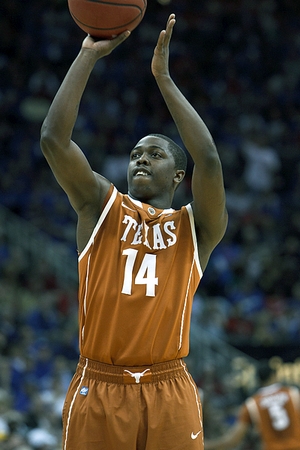
Derek Bodner
J'Covan Brown finished off his sophomore year with his most consistent stretch of basketball to date. Coming off the bench all year, Brown scored in double figures in 7 of his last 8 games, and followed that up with 22 points per game while going 25-25 from the free throw line during the NCAA tournament.
Brown's role as an offensive spark off the bench was largely the same as he filled during his freshman year, but how he came about that changed significantly with the arrival of Cory Joseph at the point. Brown has been asked to create less in half-court sets last year than he did during his freshman campaign and the result was a more efficient season scoring the basketball, raising his true shooting percentage from 49.3% to a much more efficient 56%.
Used heavily as a pick and roll player his freshman year, Brown saw his shot-creating responsibilities drop substantially, instead becoming more of a catch and shoot and spot-up shooter, where he flourished. Brown has a quick release, gets good elevation on his jump shot and shows good consistency in his release when he gets his feet set. 42% of his field goal attempts came from beyond the arc last season, and he converted a solid 38.5% of those attempts.
When Brown gets in the paint, things become a little more murky, as he struggles to finish around the basket. Playing largely below the rim, Brown doesn't have great body control or touch around the rim, particularly with his off hand. He only converted 42% of his 2-point attempts last season, which ranks as one of the poorest rates in college basketball amongst guards.
Despite a sizable drop in usage in pick and roll sets -- they were over 30% of his offense his freshman year, which was down to 14% his sophomore year, according to Synergy Sports Technology -- pick and rolls still take up a significant amount of Brown's half-court offense, and it's mostly a mixed bag. Brown shows the ability to make shots off the dribble, has range to make shots off the pick and roll, and did a much better job of drawing contact last season than he had in his freshman year.
That being said, his previously mentioned struggles finishing at the rim and his limited playmaking ability limit his usefulness in this regard. An improved mid-range game would help Brown establish himself better in pick and roll sets, and give defenders another facet of the game to concentrate on when defending him.
Brown's ability to play the point is still a huge question mark, and one he's not likely to get a chance to fully prove with Myck Kabongo replacing the departed Cory Joseph for the Longhorns. He doesn't have particularly good court vision, and doesn't have an offensive set he can consistently create for his teammates from. He's done a better job of limiting his mistakes and careless turnovers, but he will still occasionally force a pass from time to time.
Brown's shot selection was a huge question mark his freshman year, and from time to time he will still launch an ill-advised jumper early in the shot clock, particularly in transition. That being said, it has improved considerably, particularly in half-court sets where he now has a much more defined role, and one that suits his skill-sets better.
Brown moves his feet well defensively, but at 6'1 can be susceptible to bigger guards, and would have considerable trouble defending the shooting guard position with regularity at the next level.
The move off the ball helped Brown become a much more efficient contributor, finding a consistent role in Texas' offense. He butted heads consistently with Coach Barnes up until this point, at times showing poor body language and being benched for his selfish play. With the loss of three first round picks and the arrival of highly touted point guard Myck Kabongo, Texas is going to be a very different team this year, and it will be interesting how this change in personnel affects Brown's usage, and whether or not he can develop into more than a spark off the bench.













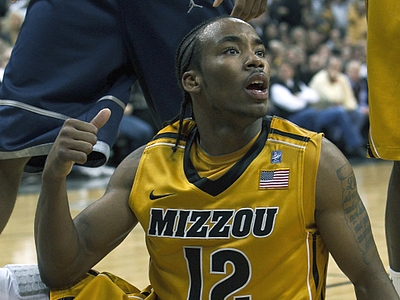




















Comments